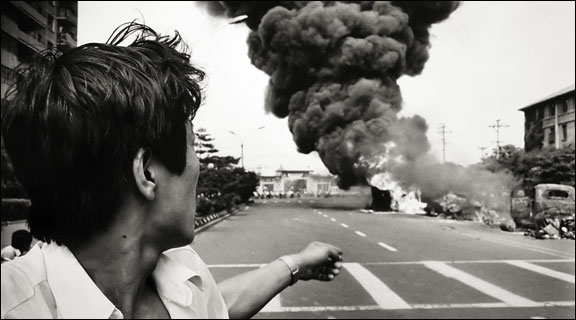Ten Days in Tiananmen Square
Ten Days in Tiananmen Square
B. Gannon: Ten Days in Tiananmen Square

In 1989, I went to China out of personal interest and believed the events in Tiananmen Square would be over by the time I’d arrived. The protest in Tiananmen had been in progress for some weeks prior to my arrival and in the ten days I was there, I moved freely about the students and demonstrators, documenting their daily events and routines, which at times felt like a street festival.
My camera carried me around. It led me—in the defiance of martial law (who was taking martial law seriously, anyway?)—on the student marches around central Beijing; to the campus of the city’s university; to the Monument of the Heroes in Tiananmen Square, where student leaders were making speeches proclaiming their demands for the immediate future.



I thought I was prepared for many surprises: the foot-bound octogenarians hobbling down the Donchang’an Jie; the squares filled with the slow-paced dance of Tai Chi practitioners; and that ubiquitous government voice, bellowing from the speakers that surrounded Tiananmen Square, telling the students and protesters to return to their homes.
The events, in real life, were just as exotic and strange but never wholly threatening. The army was an ever-present specter—the army that, I was told, would never shoot the people—and its profile ominously grew as those final days approached. But I was not prepared—in fact, hopelessly ill prepared (as were many people)—for the bloody denouement of the protest.


On the final night of my stay (June 3, 1989), massive PLA troop movements around the square began, concluding in an all-out assault that culminated in retaking—by violent force—Tiananmen and the surrounding areas. A full scale riot ensued. I witnessed numerous deaths of both protesters and PLA soldiers.
Finally, in the early hours of the June 4, I photographed a number of badly injured soldiers in a hotel lobby, and was attacked by non-uniformed personnel. I was threatened and forced to remove film from my camera and pockets. The rolls of film were confiscated and never returned.
Later that day, I caught a cab to the airport and returned on my scheduled flight to the UK.
Read more from our archives on Tiananmen
Bob Gannon is a self-taught freelance photojournalist, whose photographs have appeared in the Guardian, the Times of London, the Observer and numerous other publications. He has photographed Nicaragua, El Salvador and Israel. This article was originally posted on our Web site in 2007.




